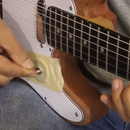Introduction: Massive Standing Desk With 2x4s and MDF Surface
Would you like a standing desk? How about one that is quite large?
This desk is in fact both of those things, and measures in at 71" x 33" x 43" high. You can see me, what many people would consider a massive man at 6'4", 260 lbs standing behind it. The second picture shows just some of the assorted electronics that can be stored on its surface.
Follow along to see how to build this out of 2x4s, MDF, and 2x6s. A video of the whole build is available here, also embedded below.
Also, before starting this, measure your doors and hallways to make sure you can get it into your chosen workspace!
Step 1: Video:
Here's the video of me constructing this massive device.
Step 2: Parts Needed:
You'll need lumber and MDF cut in the following sizes:
- (4) 2x6 43" vertical supports
- (2) 2x4 71" front/back supports
- (7) 2x4 30" side supports and bottom feet*
- (1) 2x6 65" back support
- (1) 1/2" MDF 31" x 69" main surface
- (2) 2x6 10" mid supports
Additionally:
- Wood screws 2 1/2" lg
- stain/urethane
*6 noted in the drawing, had to add another later.
Step 3: Cut 2x4 and 2x6s
Cut as noted in the previous step. Shoes recommended throughout the build process, btw.
Step 4: Route and Sand
Route a radius on edges as desired and sand.
Route a 1/2" by 1/2" cavity to the (2) 71" 2x4s and (2) of the 30" 2x4 lengths.
Ideally, leave around 3/4" uncut on either side of the 71" sections.
Step 5: Assemble Legs
Assemble the legs as shown here, referring back to the CAD model as needed. Make sure you get the angles right, I checked this over and over. Also note that it's important the side supports are not made identical, but as mirror images of each other.
Step 6: Add Middle Support and Back 2x4
Assemble the middle 65" 2x6back support as shown, along with one of the 71" 2x4s with the square cavity facing into the desk and up to accommodate the MDF.
Step 7: Flip and Add MDF
Now for the real test! Flip your creation onto it's legs and if it holds up, slide the MDF on top of it.
If it fits, great. If not, check the MDF to make sure you (or the hardware store) cut it correctly - you may have to modify things as needed.
Step 8: Install Front 2x4
Use a ratchet strap as needed to keep things together, and install the other long 2x4.
Step 9: Add Middle Support
I wasn't sure if I'd have to, but in order to keep the middle together and further support the MDF surface, install a 30" piece of 2x4 in the middle.
Step 10: Optional: Engraving
As I've got a CNC router, this seemed like an ideal time to add my name/logo.
Technique was to spray paint everything, then remove the non-recessed surface with a sander. Turned out quite nicely!
Step 11: Add Middle Leg Support
Engraved or not, you'll want to add a middle support. I used a pocket hole jig available here on Amazon*, which worked quite well for this simple job.
The jig instructions say not to use angled screws, but I didn't let that piece of paper boss me around, and used the same screws as went elsewhere on the build.
*Affiliate link
Step 12: Stain and Urethane
Stain, urethane, urethane. It always seems like such a hassle, but the results are really worth it.
In my limited experience, I prefer actual stain to combo "urestain," but that would have saved me a step, so do as you will. Or don't stain it at all!
Step 13: Re-install MDF and Cut Hole
Put the MDF back in. Actually had to sand it to make it fit - apparently it was a little too tight.
Also drilled a hole for my desk lamp and possibly extension cords. The great thing about the surface is that if you screw something up, you can just cut another piece of MDF (or whatever) and replace it will hopefully very little fuss.
Step 14: Enjoy!
And here's how it came out. Pretty neat!
I make all sorts of things, and if you'd like to see my other crazy contraptions, check out my YouTube channel here.













